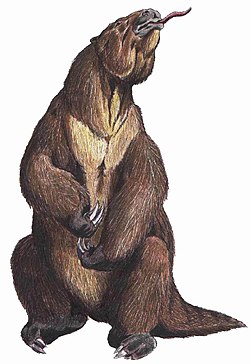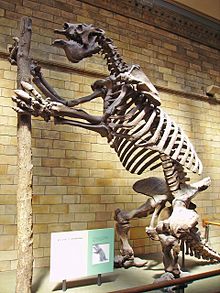Megatherium: Difference between revisions
No edit summary |
m →Evolution: Some Brazilian scientists believe... |
||
| Line 51: | Line 51: | ||
== Evolution == |
== Evolution == |
||
{{weasel}} |
|||
The ground sloths, as with all other [[edentate]], evolved in isolation in South America, while it was an island during the [[Paleogene]]. During the [[Pliocene]], the [[Central American Isthmus]] formed, causing the [[Great American Interchange]], and a mass extinction of much of the indigenous South American megafauna. Ground sloths were largely unaffected and continued to thrive in spite of competition from the northern immigrants. In fact, ground sloths were among the various South American animal groups to migrate northwards, into North America, where they remained and flourished until the late Pleistocene.{{Verify source|date=January 2008}}<!-- "ground sloths" are not a monophyletic group! --> In the south, the giant ground sloth flourished until about 10,000 years ago. Some cite the appearance of human hunters as the cause of its extinction, others climatic changes; however, the actual cause is unknown. |
The ground sloths, as with all other [[edentate]], evolved in isolation in South America, while it was an island during the [[Paleogene]]. During the [[Pliocene]], the [[Central American Isthmus]] formed, causing the [[Great American Interchange]], and a mass extinction of much of the indigenous South American megafauna. Ground sloths were largely unaffected and continued to thrive in spite of competition from the northern immigrants. In fact, ground sloths were among the various South American animal groups to migrate northwards, into North America, where they remained and flourished until the late Pleistocene.{{Verify source|date=January 2008}}<!-- "ground sloths" are not a monophyletic group! --> In the south, the giant ground sloth flourished until about 10,000 years ago. Some cite the appearance of human hunters as the cause of its extinction, others climatic changes; however, the actual cause is unknown. |
||
The oldest (and smallest) species of ''Megatherium'' is ''[[Megatherium altiplanicum|M. altiplanicum]]'' of Pliocene [[Bolivia]]. It was very similar to the [[Miocene]] ground sloth, ''Promegatherium'', and was about the size of a rhinoceros. Species of ''Megatherium'' became larger and larger, with the largest species, ''M. americanum'' of the late Pleistocene, reaching the size of an [[African Elephant]]. |
The oldest (and smallest) species of ''Megatherium'' is ''[[Megatherium altiplanicum|M. altiplanicum]]'' of Pliocene [[Bolivia]]. It was very similar to the [[Miocene]] ground sloth, ''Promegatherium'', and was about the size of a rhinoceros. Species of ''Megatherium'' became larger and larger, with the largest species, ''M. americanum'' of the late Pleistocene, reaching the size of an [[African Elephant]]. |
||
Some Brazilian scientists believe that reports of a seven foot tall creature called a [[Mapinguari]] (pronounced ma-ping-wahr-EE) may be a remnant population of the species. It is said to emit a disagreeble odor and have thick, matted fur that makes it nearly impervious to bullets and arrows. Expeditions to find specimens have proved fruitless. Other scientists believe that the reports are legends based on human contact with the last megatheriums. |
Some Brazilian scientists {{fact}} believe that reports of a seven foot tall creature called a [[Mapinguari]] (pronounced ma-ping-wahr-EE) may be a remnant population of the species. It is said to emit a disagreeble odor and have thick, matted fur that makes it nearly impervious to bullets and arrows. Expeditions to find specimens have proved fruitless. Other scientists believe that the reports are legends based on human contact with the last megatheriums. |
||
==Megatherium In Popular Culture== |
==Megatherium In Popular Culture== |
||
Revision as of 21:12, 16 March 2008
This article may require copy editing for grammar, style, cohesion, tone, or spelling. (January 2008) |
This article needs additional citations for verification. (January 2008) |
This article includes a list of references, related reading, or external links, but its sources remain unclear because it lacks inline citations. (February 2008) |
| Megatherium | |
|---|---|

| |
| Illustration of Megatherium. | |
| Scientific classification | |
| Kingdom: | |
| Phylum: | |
| Class: | |
| Superorder: | |
| Order: | |
| Family: | |
| Genus: | Megatherium Cuvier, 1796
|
| Type species | |
| Megatherium americanum Cuvier, G., 1796 | |
| Species | |
| |
Megatherium ("Great Beast") was a genus of elephant-sized ground sloths that lived from 2 million to 8,000 years ago. A related genus was Nothrotheriops, which were primarily bear-sized ground sloths. The rhinoceros-sized Promegatherium is suggested to be the ancestor of Megatherium.
Characteristics

Unlike its living relative, the tree sloth, Megatherium was one of the largest mammals to walk the Earth. Weighing as much as an African bull elephant, it had huge claws on its feet. These claws meant that it could not put its feet flat on the ground and so, like a modern anteater, it had to walk on the sides of its feet. Its footprints show that it walked mainly on its hind legs. When it stood on its hind legs, it was about twice the height of an elephant, or about twenty feet tall. They were one of the abundant Pleistocene megafauna - a wide variety of very large mammals that lived during the Pleistocene epoch.
Megatherium had a robust skeleton with a large pelvic girdle and a broad muscular tail. Its large size and specially adapted body made it possible to feed at heights otherwise unobtainable by other contemporary herbivores. Rising on its powerful hind legs and using its tail to form a tripod, Megatherium was able to support its massive body weight while using its long forelegs with curved claws to pull down branches with the choicest leaves. Its large deep jaw is believed to have housed a long tongue, as in the modern tree sloth, which it would then use to pull leaves into its mouth.
Some recent morpho-functional analysis (Bargo, 2001) indicate that M. americanum was well adapted for strong and mainly vertical biting. The teeth are extremely hypsodont and bilophodont, and the sagittal section of each loph is triangular with a sharp edge. This suggests that the teeth were used mainly for cutting, rather than grinding, and that hard and fibrous food was not the main dietary component.
There is a common misbelief that the sabre-toothed cat Smilodon hunted Megatherium, but the sloths were far too big for even this large cat to attack. Richard Fariña and Ernesto Blanco of the Universidad de la República in Montevideo have analysed a fossil skeleton of M. americanum and discovered that its olecranon—the part of the elbow to which the triceps muscle attaches—was very short. This adaptation is found in carnivores and optimises speed rather than strength. The researchers say this would have enabled M. americanum to use its claws aggressively, like daggers (Fariña and Blanco, 1996). The conclusion is that due to its nutrient-poor habitats, Megatherium may have actually taken over the kills of Smilodon. A number of adult Glyptodon fossils have also been found where the shell was turned upside down. This hints at Megatherium scavenging or hunting this animal, as no other known animal existed in South America during that period that could flip an adult Glyptodon.
Distribution
Megatherium was endemic to South America (McKenna and Bell, 1997).
Habits

Little is known about the giant ground sloth, but it is known that it was big and powerful. When it stood on its hind legs it was about twice the height of an elephant. Its very thick skin, which was covered with dense, heavy fur, protected it from predators. The giant ground sloth was an herbivorous animal that fed mainly on plants that grew on the ground. It is believed that the giant sloth lived in groups, but it may have lived singly in caves.
Diet and feeding habits
The giant ground sloth lived in the lightly wooded areas of South America, feeding on the leaves such as yuccas, agaves, and grasses. The closely related genus Eremotherium lived in more tropical environments further north. Pulling itself upright to sit on its haunches or to stand, the giant ground sloth balanced its weight with its tail. It then tugged at plants with is feet, digging them up with the five sharp claws on each foot. The sloth used its simple teeth to grind down food before swallowing it, and its highly developed cheek muscles helped in this process. The sloth's stomach was able to digest coarse and fibrous food. For millions of years, the sloth had no enemies to bother it, so it was probably a diurnal feeder. It is likely that it spent a lot of time resting to aid digestion.
Evolution
This article contains weasel words: vague phrasing that often accompanies biased or unverifiable information. |
The ground sloths, as with all other edentate, evolved in isolation in South America, while it was an island during the Paleogene. During the Pliocene, the Central American Isthmus formed, causing the Great American Interchange, and a mass extinction of much of the indigenous South American megafauna. Ground sloths were largely unaffected and continued to thrive in spite of competition from the northern immigrants. In fact, ground sloths were among the various South American animal groups to migrate northwards, into North America, where they remained and flourished until the late Pleistocene.[verification needed] In the south, the giant ground sloth flourished until about 10,000 years ago. Some cite the appearance of human hunters as the cause of its extinction, others climatic changes; however, the actual cause is unknown.
The oldest (and smallest) species of Megatherium is M. altiplanicum of Pliocene Bolivia. It was very similar to the Miocene ground sloth, Promegatherium, and was about the size of a rhinoceros. Species of Megatherium became larger and larger, with the largest species, M. americanum of the late Pleistocene, reaching the size of an African Elephant.
Some Brazilian scientists [citation needed] believe that reports of a seven foot tall creature called a Mapinguari (pronounced ma-ping-wahr-EE) may be a remnant population of the species. It is said to emit a disagreeble odor and have thick, matted fur that makes it nearly impervious to bullets and arrows. Expeditions to find specimens have proved fruitless. Other scientists believe that the reports are legends based on human contact with the last megatheriums.
Megatherium In Popular Culture
- In Jules Verne's Journey to the Center of the Earth, they encountar a giant ground sloth.
- In the 2003 Animal Planet series, Giant Monsters, Jeff Corwin sees a Megatherium fighting a Smilodon.
- Sid the Sloth from Ice Age (film) and Ice Age 2: The Meltdown is a Megatherium, despite that he is too short and weak to be one.
- In the Simpsons Treehouse of Horror V episode, Time and Punishment, Homer Simpson goes back in time to what appears to be the Late Cretaceous and encounters a giant sloth.
- In the classic cartoon series, The Tick, a giant ground sloth crashes into the Tick's tent and snatches the Tick's sidekick, Arthur.
- A Megatherium is depicted in the BBC series, Walking with Beasts, eating a dead Macrauchenia and even killing a Smilodon.
See also
References
- McKenna, M. C, and S. K. Bell. 1997. Classification of Mammals Above the Species Level. Columbia University Press, New York, 631 pp.
- Bargo, M. S. (2001). "The ground sloth Megatherium americanum: Skull shape, bite forces, and diet". Acta Palaeontologica Polonica. 46 (2): 173–192.
- Fariña, R. A. (1996). "Megatherium, the stabber". Proceedings of the Royal Society of London. 263: 1725–1729.
{{cite journal}}: Unknown parameter|coauthors=ignored (|author=suggested) (help)
- "According to locals, slothlike monster roams Amazon". Dallas News. 2007-07-28.
{{cite news}}: Check date values in:|date=(help)
Gallery
Megatherium americanum






